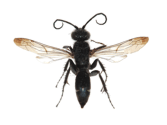44 species of spider eating wasps now recorded for the UK
 Episyron gallicum (Tournier, 1889) .
Episyron gallicum (Tournier, 1889) .
Royal Society for the Protection of Birds in Sandy, Bedfordshire have worked with the owners of a nearby and now unused quarry owned by, Lafarge Aggregates Ltd, to create a custom-built habitat ideal for rare insects.
Episyron gallicum (Tournier, 1889) a pretty, dark bodied wasp was discovered after Lafarge agreed to fund a survey of one of their disused quarries to see if the work had been successful in attracting insects to the site. In all 135 species were found at the quarry.
It is a thermphilous species normally found in a Mediterranean climate, although it is known in Poland (Sufficently common in Poland to have a popular name Opylec ciemny ) and is in their Red Book of protected species where they say it is withdrawing from many localities in Europe. The Natural History Museum of Denmark also has specimens in their collection from Iceland , Denmark and the Faroe Islands, including one of ssp. intermedium. (Haupt) of which there is one in the German Entomoligical Collection from 1930.The Checklist of the Pompilidae from Germany bases on Oehlke, Smissen & Wolf (2001) also includes Episyron gallicum where it also appears n the Book Rote Liste gefährdeter Tiere Deutschlands (BINOT et al. 1998)
The Polish Red Data Books says ..
In Poland it was only noted in the Pomeranian Lake District and in the Mazovian Lowland. In 1976 one individual of Episyron gallicum was collected in the Małopolska Upland. It is declining principally due to successional changes in xerothermic communities which are its preferred habitat. If not grazed or mown, these communities turn into thermophilous shrubs and forests. The species is not protected by law; active protection of its habitats is required.
Episyron gallicum seeks out spiders which hunt their prey on the ground rather than building webs. It is very fast and nimble, dancing around its ground living spider prey, to outwit it before paralysing it with a quick sting.
The paralysed spider is then sealed in a tunnel with a wasp egg laid on it. When the larva hatches, the comatose spider is a handily placed and tasty larder for it's first meals.
Peter Bradley, site manager at the RSPB reserve, said “It’s entirely new to this country. It is a species of specialist wasp that lives in dry and loose sand. I’m pretty sure it’s living there and breeding.”
Mr Bradley was convinced the work done by the RSPB had made it possible for the creature to make its home on this side of the Channel.
He said: “What usually happens with quarries is they are great for these rare invertebrates for a short period of time, while there is lots of disturbed dry sand and cliff faces. But after a few years they get filled in or nicely profiled by grass, or the cliff face runs out of coarse material. (Vide Poland re the growth of scrub)
“The idea here was that we create a structure that naturally creates new areas of loose sand by gradually eroding... the results are amazing".
Gavin Broad, a zoologist with At the Biological Records Centre, is of the opinion that climate change may have combined with work done at the quarry to create good conditions for the colonist. This, considering the Danish, German and Polish records over decades seems unlikely, a happy accident of habitat, intense surveying and some happy munching spiders.
He said: “There are all sorts of species in Europe that aren’t here and various insects have been changing their ranges since the last ice age. The change to warmer summers and winters is going to help them.
There were 43 species of spider-hunting wasps native to the UK to which we can add another.
Among the other unexpected finds were an endangered robberfly, which was previously confined to The Brecks area of Norfolk and Suffolk, a ground nesting, weevil-hunting wasp and several kinds of rare bees.
Lafarge are delighted with the results and Tim Deal said : “It’s great that we have found something of national interest, very possibly as a result of the restoration work we have done at the quarry. “We would feel slightly disappointed to have funded the work and found nothing.”

2 comments:
Don't know if of interest for you. But I landed in Hospital yesterday after the bite of an insect I couldn't identify. It was wasp like but rather black than yellow. I have a sever allergic reaction to wasps and reacted to the sting with an allergic reaction, not very sever but nevertheless. I was stung while walking on the beach in Gdansk Poland.
I was sitting outside one afternoon on a hot day - it was approximately 31 degrees celcius - when I looked over to a nearby spiderweb, and a similar-looking bug to the one described here landed on the web, and it looked caught. But it wasn't, and instead started to bounce; the spider came down, thinking it had caught something, and this bug grabbed the spider instead and flew away. I was wondering if it's possible for it to be this particular insect, considering I live in Canada.
Post a Comment